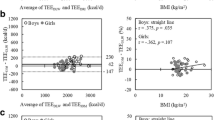Abstract
Water homeostasis is essential for life and optimal function and considerable interest surrounds the issue of recommendations for water consumption in healthy individuals. Objective data on water turnover in free-living individuals are limited, however. The aim of the present work was to measure water turnover in children and young adults using isotopically labeled water to provide objective data on magnitude and variability in relation to body weight, fat-free mass and physical activity level. Water turnover was measured by deuterated water dilution in 91 healthy children (40 boys, 51 girls; age 5–14 years) and 109 healthy young adults (80 women, 29 men; age 18–27 years) with a wide range of body mass index (13.3–51.8 kg/m2) and percent body fat (6.1–59.3%). Total energy expenditure (TEE) and resting metabolic rate were measured by the doubly labeled water technique and indirect calorimetry, respectively. Water turnover was 1.77 ± 0.57 (SD), 1.79 ± 0.44, 2.85 ± 0.82, and 3.90 ± 0.81 L/day in girls, boys, women, and men, respectively. Water turnover indexed to body surface area did not differ significantly between girls and women but was higher in men than boys. Water turnover indexed to TEE was 0.8 mL/kcal in girls and boys and 1.0 mL/kcal in women and men. This study provides objective data on water turnover for children and young adults in a temperate climate and shows that anthropometric parameters can account for the variation between girls, boys and women but not between these groups and the more active men.
Similar content being viewed by others
References
Bossingham MJ, Carnell NS, Campbell WW (2005) Water balance, hydration status, and fat-free mass hydration in younger and older adults. Am J Clin Nutr 81:1342–1350
Coward WA, Ritz P, Cole TJ (1994) Revision of calculations in the doubly labeled water method for measurement of energy expenditure in humans. Am J Physiol 267:E805–E807
Fomon SJ, Haschke F, Ziegler EE, Nelson SE (1982) Body composition of reference children from birth to age 10 years. Am J Clin Nutr 35:1169–1175
Food and Nutrition Board (1989) Recommended Dietary Allowances, 10th edn. National Academy Press. Washington
Fusch C, Hungerland E, Scharrer B, Moeller H (1993) Water turnover of healthy children measured by deuterated water elimination. Eur J Pediatr 152:110–114
Jequier E, Constant F (2010) Water as an essential nutrient: the physiological basis of hydration. Eur J Clin Nutr 64:115–123. doi:10.1038/ejcn.2009.111
Johansson G, Wikman A, Ahren AM, Hallmans G, Johansson I (2001) Underreporting of energy intake in repeated 24-hour recalls related to gender, age, weight status, day of interview, educational level, reported food intake, smoking habits and area of living. Public Health Nutr 4:919–927
Leiper JB, Carnie A, Maughan RJ (1996) Water turnover rates in sedentary and exercising middle aged men. Br J Sports Med 30:24–26
Leiper JB, Seonaid Primrose C, Primrose WR, Phillimore J, Maughan RJ (2005) A comparison of water turnover in older people in community and institutional settings. J Nutr Health Aging 9:189–193
Lohman TG (1986) Applicability of body composition techniques and constants for children and youths. Exerc Sport Sci Rev 14:325–357
Mosteller RD (1987) Simplified calculation of body-surface area. N Engl J Med 317:1098
Otten J, Helling J, Meyes L (eds) (2006) Dietary reference intakes, the essential guide to nutrient requirements. National Academy Press, Washington
Raman A, Schoeller DA, Subar AF, Troiano RP, Schatzkin A, Harris T, Bauer D, Bingham SA, Everhart JE, Newman AB, Tylavsky FA (2004) Water turnover in 458 American adults 40–79 yr of age. Am J Physiol Renal Physiol 286:F394–F401
Rush EC, Plank LD, Coward WA (1999) Energy expenditure of young Polynesian and European women in New Zealand and relations to body composition. Am J Clin Nutr 69:43–48
Rush EC, Plank LD, Davies PS, Watson P, Wall CR (2003) Body composition and physical activity in New Zealand Maori, Pacific and European children aged 5–14 years. Br J Nutr 90:1133–1139
Rush EC, Valencia ME, Plank LD (2008) Validation of a 7-day physical activity diary against doubly-labelled water. Ann Hum Biol 35:416–421
Rush EC, Chhichhia P, Hinckson E, Nabiryo C (2009) Dietary patterns and vitamin B(12) status of migrant Indian preadolescent girls. Eur J Clin Nutr 63:585–587
Schoeller DA, Ravussin E, Schutz Y, Acheson KJ, Baertschi P, Jequier E (1986) Energy expenditure by doubly labeled water: validation in humans and proposed calculation. Am J Physiol 250:R823–R830
Valtin H (2002) “Drink at least eight glasses of water a day.” Really? Is there scientific evidence for “8 × 8”? Am J Physiol Regul Integr Comp Physiol 283:R993–1004. doi:10.1152/ajpregu.00365.2002
Weir JB (1949) New methods for calculating metabolic rate with special reference to protein metabolism. J Physiol 109:1–9
Westerterp KR, Plasqui G (2004) Physical activity and human energy expenditure. Curr Opin Clin Nutr Metab Care 7:607–613
Westerterp KR, Plasqui G, Goris AH (2005) Water loss as a function of energy intake, physical activity and season. Br J Nutr 93:199–203. doi:S0007114505000267
Acknowledgments
The contribution of the subjects and their families is gratefully acknowledged. These studies were supported by grants from the Health Research Council of New Zealand, the Auckland Institute of Technology contestable research fund, and the New Zealand Ministry of Health.
Conflict of interest
The authors declare no conflict of interest.
Author information
Authors and Affiliations
Corresponding author
Additional information
Communicated by Klaas Westerterp.
Rights and permissions
About this article
Cite this article
Rush, E.C., Chhichhia, P., Kilding, A.E. et al. Water turnover in children and young adults. Eur J Appl Physiol 110, 1209–1214 (2010). https://doi.org/10.1007/s00421-010-1621-5
Accepted:
Published:
Issue Date:
DOI: https://doi.org/10.1007/s00421-010-1621-5




